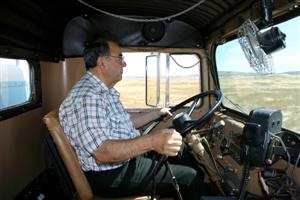COVER FEATURE - SEPTEMBER 2005
“OLDE
SCHOOL” TRUCKER
Defining
the Term Defines the Man – or Does It?
By Daniel J. Linss - Editor
Nowadays when you hear the term “Old School” your mind immediately conjures up sights, sounds and styles that were popular just a few years ago. But long before the hip-hop scene got hold of the phrase and twisted the sense of what “old” really meant, Ed Rocha was running trucks and doing things the only way he knew how. And over fifty years later, he’s still doing things in the same way – truly “old school” in its purest form. We might even go so far as to call it “Olde School” instead.
Back in the 1950s when Ed was just getting started, the trucks were rough and so were the drivers. It was a simpler time – a time before cell phones, e-mail, computers, cruise control, air-ride suspensions, satellite tracking, and big comfortable sleepers. But yesterdays trucks were good – no plastic, no glue, no fancy electronics – just a solid, hard-working piece of equipment that, if properly cared for, would last a very long time.
Although semi-retired from trucking, Ed spends much of his time staying active in trucking organizations and restoring old trucks. He currently has ten trucks that have been rebuilt to nearly exact specifications of the trucks he drove back in the 1950s. The cattle-hauling KW on our cover this month is a perfect example. Ed takes this fleet of restored rigs to various trucking events across the country – he doesn’t want the “Olde School” trucks and lifestyle to be forgotten.
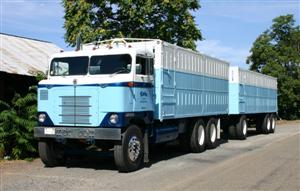 Ed’s
father John started trucking in 1924 under the name John N. Rocha Transportation,
hauling mostly milk, hay and dairy supplies. In 1935, he decided to get
more involved with cattle, and had a GMC truck and trailer built by Talbert
Iron Works in Modesto. After the truck was completed, they realized it
was too tall to get out the door, so they took the tires off and skidded
it out. In 1952, when Ed was a senior in high school, his dad took him
to Salinas Dressed Beef Company to look at two nearly-new 1951 Peterbilt
cabovers they had for sale. His dad told him, “If I like the deal, you’re
in business.” They ended up buying the trucks (with jobs) and Ed and his
father became partners under the name Rocha Livestock Transportation.
Ed’s
father John started trucking in 1924 under the name John N. Rocha Transportation,
hauling mostly milk, hay and dairy supplies. In 1935, he decided to get
more involved with cattle, and had a GMC truck and trailer built by Talbert
Iron Works in Modesto. After the truck was completed, they realized it
was too tall to get out the door, so they took the tires off and skidded
it out. In 1952, when Ed was a senior in high school, his dad took him
to Salinas Dressed Beef Company to look at two nearly-new 1951 Peterbilt
cabovers they had for sale. His dad told him, “If I like the deal, you’re
in business.” They ended up buying the trucks (with jobs) and Ed and his
father became partners under the name Rocha Livestock Transportation.
In 1963, Ed decided to go out on his own and started Ed Rocha Livestock Transportation. Over the years, he built up his fleet. In 1972 he built a terminal in Stockton, CA and moved there. In 1989, he built a second terminal in Modesto, CA. At that time, one of his sons, who was running the Stockton terminal, got killed in a train accident. Ed couldn’t run both facilities, so he closed down the Stockton terminal and moved everything to Modesto.
In 1990, Ed started another company called Valley Enterprises, which specialized in not only running trucks but leasing tomato trailers. Throughout the 1990s, he built his fleet up to 65 trucks after landing a big contract with Gallo Wine. At that time he had tankers, vans, curtain vans, and of course, cattle trucks. Ed’s youngest son Douglas helped out a lot. In fact, at twelve years old, Doug was running the tomato trailer operation on his own – and at that time, the operation was moving 100 loads a day! Doug’s younger sister Stephanie, at only nine years old, would help too. After high school, Doug went on to college to study Ag Business. After graduating, he came back to help his dad run the company.
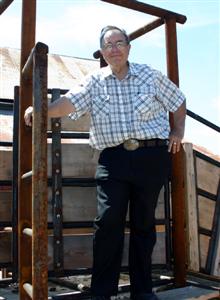 In
2000, Ed sold off everything associated with Ed Rocha Livestock Transportation
and moved to Oakdale, CA. Ed bought an eight-acre parcel and built a beautiful
new facility for Valley Enterprises. On the site, he built a 14,000 square-foot
shop which, partly, is used to build, maintain and store all of his old
trucks. Currently, Valley Enterprises owns 13 trucks and has one leased-on
carrier. They run three cattle trucks (one more is on the way) and the
rest of the fleet is dedicated to hauling loads for Gallo Wine. They deliver
the wine locally and also shuttle products (like bottles and boxes) from
local companies to the winery. They also have a few trucks that do nothing
but shuttle product within the Gallo yard, from area to area, 24 hours
a day. Today’s fleet is mostly Freightliner conventionals, with the exception
of one Pete cabover they still run. Doug pretty much runs the operation
now, while Ed spends most of his time working with industry associations
and tinkering with his classics.
In
2000, Ed sold off everything associated with Ed Rocha Livestock Transportation
and moved to Oakdale, CA. Ed bought an eight-acre parcel and built a beautiful
new facility for Valley Enterprises. On the site, he built a 14,000 square-foot
shop which, partly, is used to build, maintain and store all of his old
trucks. Currently, Valley Enterprises owns 13 trucks and has one leased-on
carrier. They run three cattle trucks (one more is on the way) and the
rest of the fleet is dedicated to hauling loads for Gallo Wine. They deliver
the wine locally and also shuttle products (like bottles and boxes) from
local companies to the winery. They also have a few trucks that do nothing
but shuttle product within the Gallo yard, from area to area, 24 hours
a day. Today’s fleet is mostly Freightliner conventionals, with the exception
of one Pete cabover they still run. Doug pretty much runs the operation
now, while Ed spends most of his time working with industry associations
and tinkering with his classics.
Ed is very active with several trucking organizations. Back in 1991, he was the president of the California Trucking Association (CTA). He has since stayed very active in the CTA, and has gone on to be a part of many other organizations. He is currently an active vice president of the American Truck Historical Society (ATHS), the executive director of the Hays Antique Truck Museum, on the Board of Directors for the American Trucking Association (ATA), and has helped start two organizations that help abused children, including a home that takes in abused and abandoned kids. He is also the regional vice president of the Westside, Coast and Tulare Chapters of the ATHS, as well as an active member of the Central California Chapter. Ed feels strongly that these organizations provide a collective voice for the trucking industry in regards to environmental issues, fuel prices, freight rates, and the industries’ lack of quality drivers. These are all important issues that need to be heard and properly explained to the people responsible for making new laws and regulations.
Ed has never been a big fan of chrome. One look at his fleet, the old trucks or the new ones, and you will see that. For him, it’s always been a matter of practicality. It doesn’t make sense, to him, to hang thousands of pounds (and dollars) of accessories on a truck and kill its efficiency. Back in the day, there wasn’t much chrome, and that’s still the way Ed likes it. Some would call his trucks plain, but he calls them neat. There he goes again with that “Olde School” attitude.
Ed’s current fleet of restored rigs includes a 1953 Pete cabover truck & trailer, a 1954 Pete cabover with a set of doubles, a 1946 Autocar, a 1966 Freightliner cabover with a sleeper that sits out over the top of the cab (the Tiltin’ Hilton), a 1963 Kenworth conventional tractor (used to pull a lowboy trailer with other trucks on it), a 1946 Peterbilt-McDonald (one-of-a-kind) conventional, a 1951 GMC half-ton flatbed pickup, a 1924 Model-T one-ton and a 1955 Freightliner Bubblenose. All of Ed’s classic trucks are interesting and each one has a story of its own, but here we’ll focus on just one particular rig.
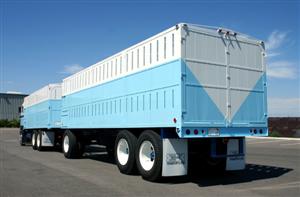 The
tenth truck in his “Olde School” fleet is the 1954 Kenworth Model 825
Bullnose truck and trailer featured on our cover and centerfold this month.
This truck was purchased in 1992 from a guy in Los Angeles. The old KW
spent most of its life hauling lumber and general freight. The truck was
completely restored to be just like the trucks Ed drove back in 1954.
Powered by a 320 horsepower Cummins with a gear-driven supercharger, Ed
claims that this rig drives as good or better than a new truck. With a
232-inch wheelbase, a 5-speed main transmission and a 4-speed Brownie,
a 26-foot bull rack, and not a stitch of chrome besides the front wheels,
the single stack and the narrow front bumper – this rig is all original.
The 1950 3-axle Weber trailer was purchased from another guy in L.A. and
then completely redone. Ed built a whole new (authentic to the era) bull
rack for the 28-foot trailer and then painted the entire combination in
the standard Ed Rocha colors of baby blue, dark metallic blue and white.
All of Ed’s trucks have been painted by his brother, Bill Rocha, who has
made a name for himself in the paint and body business. The main restoration
of this rig took about three years originally, but little things are constantly
being done to the truck to keep it up. A project like this is never complete
for long.
The
tenth truck in his “Olde School” fleet is the 1954 Kenworth Model 825
Bullnose truck and trailer featured on our cover and centerfold this month.
This truck was purchased in 1992 from a guy in Los Angeles. The old KW
spent most of its life hauling lumber and general freight. The truck was
completely restored to be just like the trucks Ed drove back in 1954.
Powered by a 320 horsepower Cummins with a gear-driven supercharger, Ed
claims that this rig drives as good or better than a new truck. With a
232-inch wheelbase, a 5-speed main transmission and a 4-speed Brownie,
a 26-foot bull rack, and not a stitch of chrome besides the front wheels,
the single stack and the narrow front bumper – this rig is all original.
The 1950 3-axle Weber trailer was purchased from another guy in L.A. and
then completely redone. Ed built a whole new (authentic to the era) bull
rack for the 28-foot trailer and then painted the entire combination in
the standard Ed Rocha colors of baby blue, dark metallic blue and white.
All of Ed’s trucks have been painted by his brother, Bill Rocha, who has
made a name for himself in the paint and body business. The main restoration
of this rig took about three years originally, but little things are constantly
being done to the truck to keep it up. A project like this is never complete
for long.
On the day of our photo shoot, a couple of Ed’s friends came along to help. Bill Richina, Gordon Evans and Bill McDowell are three guys that help Ed out with the trucks. It takes a lot of work to prepare these trucks for shows and exhibitions, not to mention getting them to the location. Since most of Ed’s trucks can be driven, these guys often help out by driving a truck to a show or simply help Ed clean them up and load them on a trailer to be hauled to an event. Ed wanted to really thank these three guys (and all the others) that help him out so much. He loves taking these trucks out to shows and events, but he couldn’t do it all by himself.
On June 14th, 2005 Ed turned 70 years old, and to celebrate, he threw a big barbecue bash and impromptu truck show at his Oakdale facility. Well over 300 people came (300 ate) and 35 antique trucks (not counting his) showed up to be on display. Family, friends and customers came to celebrate with Ed. The party went all day and didn’t end until after 8:00 p.m. that night. It was quite an event. But with age comes other problems.
A couple years ago Ed had to have triple bypass surgery after suffering a heart attack and last year he was diagnosed with Leukemia. But thanks to successful treatments and lots of pills, Ed’s Leukemia is already in remission. The heart attack was probably caused by his steady diet of beef. When we told him that we were going home that night to a barbecued chicken dinner, he about threw us off his property (okay, that statement may have been mildly exaggerated). For Ed, it’s all about the beef. But what can you expect – his whole life has been centered around cows.
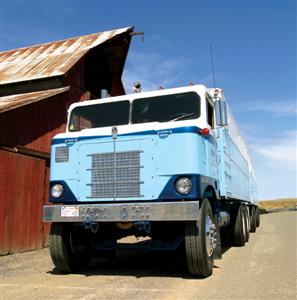 Ed
has been married to his (second) wife Carole for 27 years. They have three
children and 14 grandchildren. Carole’s job is to take care of the yard
around their home and when Ed isn’t at the office or playing with his
trucks, he takes care of their amond orchard. Apparently, if you own the
orchard, you call them amonds – if you just buy them and eat them, you
call them almonds. Based on the fact that large machines are used to violently
shake the trees until the nuts fall off, the joke goes that the growers
claim to shake the “L” out of the almonds – hence the name, amonds. Once
we got it, we had a good laugh! These orchards produce a hefty “retirement
income” for Ed and his wife, bringing in $3.00 a pound. And with an average
yield of 2,000 pounds of nuts per acre and 32 acres of trees, you can
do the math. That aint too shabby! And even better yet, Ed enjoys taking
care of the trees – he considers it his relaxing time.
Ed
has been married to his (second) wife Carole for 27 years. They have three
children and 14 grandchildren. Carole’s job is to take care of the yard
around their home and when Ed isn’t at the office or playing with his
trucks, he takes care of their amond orchard. Apparently, if you own the
orchard, you call them amonds – if you just buy them and eat them, you
call them almonds. Based on the fact that large machines are used to violently
shake the trees until the nuts fall off, the joke goes that the growers
claim to shake the “L” out of the almonds – hence the name, amonds. Once
we got it, we had a good laugh! These orchards produce a hefty “retirement
income” for Ed and his wife, bringing in $3.00 a pound. And with an average
yield of 2,000 pounds of nuts per acre and 32 acres of trees, you can
do the math. That aint too shabby! And even better yet, Ed enjoys taking
care of the trees – he considers it his relaxing time.
Ed still goes into the office every day and he even drives a load from time to time, but most of his time is spent with his “Olde School” rigs. Ed’s father died in 1989 and his mother passed away just two years ago. But they taught their son well – they taught him to work hard, be outspoken, to never give up and not to take anything for granted. Those sound like pretty “Olde School” traits – too bad the kids today who think they are “Old School” don’t get it. Frankly, the world could use more folks with Ed’s “Olde” attitude. A young local cattle hauler said it best when he said, “Ed is a legend – he’s the king!” Apparently “old” aint so bad after all – no matter how you spell it or define it.
Copyright
© 2005 10-4 Magazine and Tenfourmagazine.com
PO Box 7377 Huntington Beach, CA, 92615 tel. (714) 378-9990 fax
(714) 962-8506

